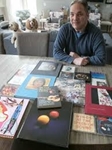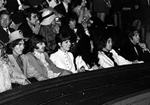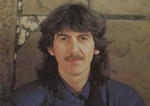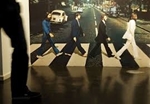- Register
- Log in to Tune-In
- Wishlist (0)
-
Shopping cart
(0)
You have no items in your shopping cart.
Beatles News

Paul McCartney has called Chinese wet markets “medieval” and blamed them for the spread of coronavirus, using a comparison with the abolition of the slave trade when calling for them to be banned.
So-called “wet markets” in Asia trade in fresh meat and produce, and sometimes feature live animals. (They take their name from the frequently hosed-down floors.) A common theory – though far from confirmed – is that Covid-19 originated in a live animal market in Wuhan, with the disease being transmitted from illegally traded bat or pangolin meat.
Speaking to US radio host Howard Stern about the coronavirus crisis, McCartney said: “I really hope that this will mean the Chinese government says, ‘OK guys, we have really got to get super hygienic around here.’ Let’s face it, it is a little bit medieval eating bats.”
Source: Ben Beaumont-Thomas/theguardian.com
details
Rare footage of late sitar player Ravi Shankar has surfaced that sees him teaching Beatles guitarist George Harrison the instrument.
The footage has been shared by The Ravi Shankar Foundation with the BBC to commemorate what would’ve been the icon’s 100th birthday (April 11).
Shankar was described as the “godfather of world music” by Harrison, and a number of celebrations in London and New York were planned to celebrate his centenary, but have been cancelled due to the coronavirus.
Instead, a new video of rare footage has been shared to mark the occasion, which features footage from a number of Shankar’s gigs, and him teaching Harrison the sitar. Watch it here via the BBC.
Source: Will Richards/nme.com
details
Fifty years since their dissolution in April 1970 the Beatles live on. The band’s music, their significance and their individual personalities exert a hold on the cultural consciousness that seems to tighten as their heyday recedes. But is there anything new to say? Craig Brown’s One Two Three Four, the latest to enter the crowded library of Beatles books, is not a biography so much as a group portrait in vignettes, a rearrangement of stories and legends whose trick is to make them gleam anew.
The subtitle, The Beatles in Time, marks out the book’s difference from the rest. Brown goes on Beatles jaunts around Liverpool and Hamburg, visits fan festivals, tests the strength of the industry that has agglomerated around them. So many of the clubs where they played are now lost or changed beyond recognition – “a memory of a memory” – and the fans who do the pilgrimages are simply chasing shadows.
Source: Anthony Quinn/theguardian.com
details
John Lennon’s “Imagine” is the most famous song from his solo career. It’s an anthem for peace and antimaterialism. Interestingly, the piano on which John composed it was owned by a different artist: George Michael.
Michael made music that was pretty far removed from John’s. However, that didn’t stop him from admiring John’s work. Here’s why he saw his purchase of John’s piano as charitable.
The piano was built in Hamburg in 1970, according to MTV News. So it was very new when John released “Imagine” in 1971. The piano can be seen in the music video for “Imagine,” which features John and his wife, Yoko Ono. Whoever built the piano probably had no idea it would become a sought-after collector’s item.
In 1992, a private collector purchased the piano, the Independent reports. That collector loaned the piano to Liverpool’s Beatles museum. Then, the collector began to think about selling the piano to wealthy Fab Four fans in Japan or the U.S.
Source: cheatsheet.com
details
At Mount Sinai South Nassau on New York's Long Island, the hospital staff reportedly spins "Here Comes the Sun" on the public address system every time a coronavirus patient is discharged. Paul McCartney is set to play the upcoming "One World: Together at Home" charity special, joining a bill that includes 18-year-old superfan Billie Eilish, nearly 60 years his junior.
"Yellow Submarine" has gained new resonance as an intergenerational singalong, crooned by neighbors through windows-turned-portholes, socially distant, but inextricably linked.
Source: Jere Hester CNN
details
"Let It Be" was a massive hit and has become one of the Beatles most popular songs, but John Lennon hated it.
The reasons are multifaceted. The clearest line can be drawn to the infamously contentious recording sessions for the Let It Be album.
By this point in their career, the Beatles were constantly fighting, with Lennon later describing the experience as “going through hell.” While Lennon and Paul McCartney had always maintained differing writing styles, their creative desires had pulled them further apart than ever before. Paul McCartney grew tired of Lennon’s experimentations, while Lennon called McCartney’s brand of storytelling songwriting “granny music.”
It should come as no surprise, then, that Lennon was immediately dismissive of the idea his songwriting partner brought to the studio in January of 1969. Explaining that he’d been inspired by a dream in which he’d seen his deceased mother, McCartney launched into the now-familiar phrases of “Let It Be.” Lennon was unimpressed, feeling that the style didn’t suit the band.
Source: ultimateclassicrock.com

Paul McCartney’s hastily scribbled notes for a 1968 studio recording fetches nine times its original estimate
Paul McCartney’s handwritten lyrics to The Beatles’ hit song Hey Jude has sold for $910,000, nine times its original estimate, auction house Julien’s Auctions said.
A vintage bass drumhead with The Beatles’ logo that was used during the English band’s first North American tour in 1964 was another top item in the auction, selling for $200,000.
The lyrics and guitar were among more than 250 items of Beatles memorabilia offered in an online auction on Friday by Julien’s Auctions in New York to mark the 50th anniversary of the band’s breakup.
A drawing by John Lennon and wife Yoko Ono called Bagism, a term they coined to satirise stereotyping, sold for $93,750, while an ashtray used by the Fab Four’s drummer Ringo Starr at the Abbey Road recording studios in London fetched $32,500.
Source: Reuters/theguardian.com
details
Self-proclaimed "opinionated" Brighton area author Ted Montgomery said he hopes he has written "a good bar stool book that gives you good things to argue over."
When it comes to music, everyone has their own likes and dislikes about what sounds good.
Montgomery, who lives in Green Oak Township said he did not hold back his personal opinions when penning his new book.
He poured over an enormous catalog of hundreds of songs by former member of The Beatles and prolific solo musician Paul McCartney.
Montgomery's new book "The Paul McCartney Catalog: A Complete Annotated Discography of Solo Works, 1967-2019" covers 52 years of music, videos, radio shows and other materials the 77-year-old British rocker released, mostly after The Beatles officially split in 1970.
The first of 18 occasions Montgomery saw Paul McCartney perform live was in 1976.
Source: Jennifer Timar, Livingston Daily
details

It was the news that had millions of fans not so much gently weeping as crying for help – the Beatles were no more.
While technically speaking the Fab Four were not officially dissolved until 1975, Paul McCartney’s bombshell press release on April 10, 1970 marks the end of the world’s favourite band.
He could see no future in his famed songwriting partnership with John Lennon, Paul said while promoting a solo album, and did not miss either George Harrison or Ringo Starr.
Five decades on and debate still rages over what – or who, in the case of Yoko Ono – broke up the Beatles.
Following the split, John, Paul, George and Ringo went their separate ways, pursuing successful solo careers while the band’s music swelled in popularity.
Here’s what they did next:
Source: breakingnews.ie
details
Fifty years ago, when Paul McCartney announced he had left the Beatles, the news dashed the hopes of millions of fans, while fueling false reunion rumors that persisted well into the new decade.
In a press release, on April 10, 1970, for his first solo album, “McCartney,” he leaked his intention to leave. In doing so, he shocked his three bandmates.
The Beatles had symbolized the great communal spirit of the era. How could they possibly come apart?
Few at the time were aware of the underlying fissures. The power struggles in the group had been mounting at least since their manager, Brian Epstein, died in August of 1967
Source: Tim Riley, The Conversation/smithsonianmag.com
details
A rare photograph of the trio who evolved into the Beatles has emerged.
The previously-unpublished photo of The Quarrymen shows Paul McCartney, John Lennon and George Harrison a year before becoming The Beatles.
The picture, captured in a Liverpool home in 1959, has surfaced on the 50th anniversary of McCartney announcing he was leaving the group.
"History shines in every dimly-lit detail," said Beatles' historian and author Mark Lewisohn.
"Within a year of this moment the Quarrymen had become The Beatles, professional musicians playing long hours in Hamburg," he added.
"Four years from here they'd have attained the inconceivable level of fame and popularity that joyously maintains to this day - out from this Liverpool room and across the universe."
Lennon formed the skiffle and rock 'n' roll group in early 1957 alongside Rod Davis, Pete Shotton, Colin Hanton, Eric Griffiths and Len Garry.
The group was later joined by McCartney and Harrison.
McCartney, Lennon and Harrison evolved into The Beatles, along with Pete Best, until he was replaced by Ringo Starr in August 1962.
Source: BBC

After eight years that shook the world, redefined music and rerouted popular culture, it took just one word to kill off the best band that ever lived. “Are you planning a new album or single with The Beatles?” Paul McCartney was asked in a press release for his first solo album McCartney, sent to journalists on 9 April 1970. Answer: “No”. And to drive the final nail home: “Do you foresee a time when Lennon-McCartney becomes an active songwriting partnership again?” “No.”
With that, the dream was over. On 10 April, the Daily Mirror ran the front-page headline “Paul Quits The Beatles”, and the media across the world ignited. Fans and reporters gathered outside the offices of Apple Corps at 3 Savile Row, distraught or eulogising. “The event is so momentous that historians may, one day, view it as a landmark in the decline of the British Empire,” reported a CBS News crew from America. “The Beatles are breaking up.”
Source: independent.co.uk
Read More<<< details

As soon as you drop the needle on side two of Abbey Road and immediately here that blissful opening chord of ‘Here Comes The Sun’ you know you’re in for a delightful treat. However, as we look to delve deeper into a Beatles classic, we’re exploring the isolated vocal version of the track which delivers the poignant uplifting lyrics to the forefront.
The back story of the song is a fascinating one. Despite the positivity that the song oozes, it was actually written during a dark period of George Harrison’s life. Following his arrest for possession of marijuana, which arrived shortly after having his tonsils removed and him quitting The Beatles briefly, the stress and negativity all got too much for the guitarist and he needed to escape.
Harrison, searching for a moment of calm. escaped to Eric Clapton’s peaceful Surrey retreat. Reflecting on the period of his life years later, he disclosed in detail in his autobiography I, Me, Mine: “‘Here Comes the Sun’ was written at the time when Apple was getting like school, where we had to go and be businessmen: ‘Sign this’ and ‘sign that.’ Anyway, it seems as if winter in England goes on forever, details

The Beatles’ classic Abbey Road is one of the most famous albums of all time. It’s famous because it includes songs like “Something” and “Come Together.” In addition, it gave us one of the most iconic images ever: its cover.
The cover shows John Lennon, Paul McCartney, George Harrison, and Ringo Starr, walking across Abbey Road. Surprisingly, the album wasn’t supposed to be called Abbey Road. It wasn’t supposed to feature Abbey Road on its cover either.
Abbey Road was originally going to be called Mount Everest. The reason? Well, the Fab Four were known for their sense of humor. They were also known for littering their albums and songs with inside jokes. One reason they liked the title Mount Everest was because engineer Geoff Emerick would smoke a brand of cigarettes called Everest.
Source: cheatsheet.com
details
Paul McCartney confirmed yesterday that he had broken with the Beatles. But it seems certain that even if he wants to, circumstances will prevent him from straying too far.
The issue is complicated by McCartney’s refusal to speak to the world beyond filling in the answers to a questionnaire drawn up by the Beatles’ organisation, Apple. He did say then he did not know whether his break with the Beatles was temporary or permanent; that he did not have any relationship with Mr Alan Klein, the Beatles business manager (a figure of some importance in this matter); that Mr Klein did not represent him in any way; that he had no plans to record with other Beatle members in the future; that he could not imagine writing with John Lennon again; and that in making his first solo album he had not missed the talents of the other Beatles.
Source: Jackie Leishman/theguardian.com
details